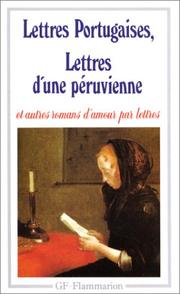| Listing 1 - 10 of 40 | << page >> |
Sort by
|

ISBN: 208070379X 9782080703798 Year: 1983 Volume: 379 Publisher: [Paris] : Flammarion,
Abstract | Keywords | Export | Availability | Bookmark
 Loading...
Loading...Choose an application
- Reference Manager
- EndNote
- RefWorks (Direct export to RefWorks)
Book
Year: 1796 Publisher: Londres [i.e. Paris?] : [s.n.],
Abstract | Keywords | Export | Availability | Bookmark
 Loading...
Loading...Choose an application
- Reference Manager
- EndNote
- RefWorks (Direct export to RefWorks)
Book
Year: 1796 Publisher: Londres [i.e. Paris?] : [s.n.],
Abstract | Keywords | Export | Availability | Bookmark
 Loading...
Loading...Choose an application
- Reference Manager
- EndNote
- RefWorks (Direct export to RefWorks)
Book
ISBN: 1315649519 1317304233 1283157438 9786613157430 1848932545 9781848932548 1848930267 9781848930261 Year: 2012 Publisher: London Pickering & Chatto
Abstract | Keywords | Export | Availability | Bookmark
 Loading...
Loading...Choose an application
- Reference Manager
- EndNote
- RefWorks (Direct export to RefWorks)
This edition connects four female writers from two different countries, presenting the English translations of two of the most popular eighteenth-century French novels and a sequel to one of them. Marie-Jeanne Riccoboni (1713-92) was an immensely popular author. Her 1759 epistolary novel Lettres de Milady Juliette Catesby à Milady Henriette Campley, son amie became a sensational bestseller. Riccoboni's plot centres on a young widow named Juliette Catesby whose fiancé disappears and eventually marries someone else. Before the inevitable happy ending, Juliette relates this story's twists and turns in letters to her friend Henriette. Translated in 1760 by Frances Brooke (1724-89), it was a great success in England and established Riccoboni's reputation. Brooke went on to publish her own first novel in 1763, the successful History of Lady Julia Mandeville, indicating that it had been written 'by the translator of Lady Catesby's letters'.
Françoise de Graffigny (1695-1758) wrote one epistolary novel, entitled Lettres d'une Péruvienne which became a bestseller in France. Set during the Spanish conquest of Peru, a princess named Zilia is kidnapped and taken to France. She writes letters of love and longing to her fiancé Aza about her experiences. Although Aza eventually abandons Zilia, she refuses to marry her French captor and instead chooses to become an author and to live alone. Graffigny's contemporaries were so dissatisfied with this feminist ending that they rewrote it repeatedly. In 1774 Graffigny's novel appeared in English translation by Miss Roberts (c.1730-88). Roberts followed this with her own sequel, Letters to and from a Peruvian Princess, which continues Graffigny's plot, resolving it in a more conformist, but nevertheless surprising, manner.
Book
ISBN: 2200343159 Year: 2007 Publisher: Paris : Armand Colin,
Abstract | Keywords | Export | Availability | Bookmark
 Loading...
Loading...Choose an application
- Reference Manager
- EndNote
- RefWorks (Direct export to RefWorks)
Book
ISBN: 2200279302 Year: 2007 Publisher: [Place of publication not identified] : Dunod Editeur,
Abstract | Keywords | Export | Availability | Bookmark
 Loading...
Loading...Choose an application
- Reference Manager
- EndNote
- RefWorks (Direct export to RefWorks)
Genre très à la mode au XVIIIe siècle, le roman par lettres fascine, aujourd'hui encore, le lecteur contemporain par l'étonnante vitalité qui l'habite. La lettre se trouve au centre de l'intrigue et suscite un duel verbal où se fait jour la subjectivité des épistoliers. L'alternance des points de vue fait du roman épistolaire une oeuvre polyphonique. Mais la lettre peut aussi être menacée d'asphyxie si le destinataire ne répond pas. Elle s'ouvre alors au monologue tragique. Ce livre propose un parcours plus formel qu'historique mettant en lumière la spécificité du genre ainsi que les raisons de son succès. Un essai de typologie permet d'en repérer les formes ; l'examen stylistique explicite les fondements du roman épistolaire et éclaire les raisons de sa modernité.
Book
ISBN: 3476015769 Year: 1997 Publisher: Stuttgart Metzler
Abstract | Keywords | Export | Availability | Bookmark
 Loading...
Loading...Choose an application
- Reference Manager
- EndNote
- RefWorks (Direct export to RefWorks)
Autobiography --- Epistolary fiction, French --- History and criticism --- Grafigny,
Book
ISBN: 9782406074021 9782406074038 2406074021 Year: 2019 Volume: 388 Publisher: Paris Classiques Garnier
Abstract | Keywords | Export | Availability | Bookmark
 Loading...
Loading...Choose an application
- Reference Manager
- EndNote
- RefWorks (Direct export to RefWorks)
Ce florilège de textes publiés par Bernard Bray entre 1975 et 2010 montre comment depuis la Renaissance les manuels épistolaires ont pu donner naissance à de véritables romans par lettres, d’Étienne Pasquier à Colette en passant par Laclos, contribuant ainsi au développement du je en littérature.
Book
ISBN: 2827107139 9782827107131 Year: 1995 Volume: 14 Publisher: Fribourg (Suisse) : Editions universitaires de Fribourg,
Abstract | Keywords | Export | Availability | Bookmark
 Loading...
Loading...Choose an application
- Reference Manager
- EndNote
- RefWorks (Direct export to RefWorks)
Epistolary fiction, French --- Roman épistolaire français --- Bibliography --- Bibliographie --- Bibliography. --- Roman épistolaire français --- Epistolary fiction [French ] --- Epistolary fiction, French - Bibliography --- ROMAN FRANCAIS --- ROMAN EPISTOLAIRE --- DIX-HUITIEME SIECLE --- BIBLIOGRAPHIES
Book
ISBN: 9782246826514 2246826519 Year: 2022 Publisher: Paris Bernard Grasset
Abstract | Keywords | Export | Availability | Bookmark
 Loading...
Loading...Choose an application
- Reference Manager
- EndNote
- RefWorks (Direct export to RefWorks)
Man-woman relationships --- French fiction. --- French literature --- French fiction --- Epistolary fiction, French.
| Listing 1 - 10 of 40 | << page >> |
Sort by
|

 Search
Search Feedback
Feedback About UniCat
About UniCat  Help
Help News
News